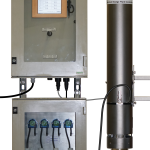
SI800 – ASP-Con
The latest precision respirometer for rapidly measuring
actual Activated Sludge bacterial performance in-situ
Applications
- Toxicity Management
- Nitrification Management
- Critical Oxygen Point analysis
- Aeration Efficiency
- Nutrient Control
- Sludge Health
- System Trouble-shooting
- Short-term BOD
- Plant capacity
- Respiration tests
SELF CLEANING – SELF CALIBRATING
ASP-CON can be installed permanently into several different areas in the Secondary Wastewater Treatment Plant to provide feed-forward or feed-back control for plant operation and optimisation. The ASP-Con carries out several continues measurements and also analyses discrete batch samples of the product to give the following parameters on a frequency which the plant operator can set:
Measurement & Benefits
DO
This continuously provides the Dissolved Oxygen level and in conjunction with the other measured variables provides a higher level of automation than is currently achieved by using this parameter alone.
Temperature
The temperature of the Mixed Liquor Suspended Solids is provided, as this affects this performance of the bacteria in the activated sludge process.
Ammonium
This parameter is reported continuously, which in combination with the critical oxygen concentration point will assist in dynamically set the plants DO set-points.
Potassium
This measurement is necessary to ensure the Ammonia result is not being impacted by high levels of potassium.
pH
This parameter is reported continuously so that any dosing required to maintain a neutral pH can be determined ensuring that nitrification is not inhibited.
MLSS
This batch measurement is then used in the control of wasting rates and to determine the F:M ratios of the plant.
SVI/SSVI
The settlement of the sludge is determined and reported so that the anticipated performance through the final clarification can be predicted.
TSS (predicted)
On the completion of the settlement test the supernatant is tested for turbidity and to indicate whether the process csn provide the required settlement during the final clarification stage.
RAS concentration
When measured this parameter, in combination with the MLSS, this will enable the plant to determine and automate the wasting of excess sludge.
Nitrification Levels
This measurement will allow the fine-tuning of the aeration system to ensure that the system will achieve its ammonia consent.
Oxygen Uptake Rate
This parameter indicates how active the bacteria are, and thus the load on the plant, as an indicator as to the optimum MLSS level.
Specific Oxygen Uptake Rate
Using the MLSS data this parameter is used to provide comparative performance of the bacteria over time to determine whether the health of the bacteria is being maintained or if there are problems within the plant. This is the first parameter to be analysed to give an indication of any toxicity problems that the plant may be experiencing.
Critical Oxygen Concentration Points
This analysis provides both the minimum DO level required for full Carbonaceous biodegradation and also the DO required for maximal ammonium depletion by the nitrifying bacteria. This provides the key to allowing the operator to dynamically set the DO set points within the plant to optimise aeration and minimise energy consumption.
Toxicity Management
The measure is provided by comparative measurements of the OUR, nitrification status, and MLSS levels and compared with a decision matrix, which indicates where toxicity is a likely source of poor bacterial performance.
The ASP-CON achieves these measurements by a combination of mechanical and analytical methods that forms the basis of controlling the secondary treatment process. This also removes the need for manually completed tests, releasing time for other priority tasks.
The instrument uses an innovative system for cleaning and calibrating, that extends the service interval time, and the design of the sample capture process, negates problems associated with ragging that afflicts some wastewater treatment plants.
The outcome of an ASP-Con controlled plant will be to achieve compliance for the optimum costs in energy and the reduction of significant CO2 emissions, and liberating labour for other priority tasks.
The Next Step Change in the Activated Sludge Treatment Process
Frank Rogalla – Director of Innovation & Technology, Aqualia.
Documentation
 Strathkelvin-Environmental-ASP-Con-Article
Strathkelvin-Environmental-ASP-Con-Article